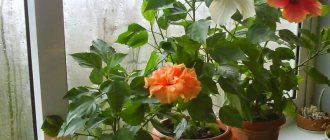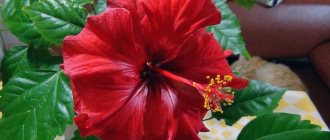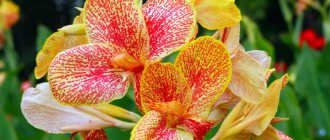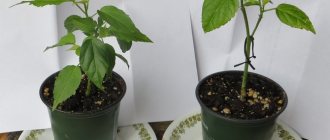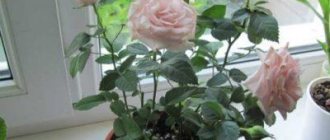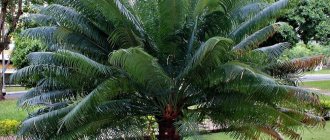Numerous species of hibiscus (Hibiscus) belong to the Malvaceae family. The homeland of these plants is Southeast Asia. The most common forms of hibiscus are shrubby and tree-like, but there are also annual herbs among them. Hibiscus has many names - Chinese rose, Sudanese rose, red sorrel, kenaf, Chinese rose, marsh mallow, etc. Flower growers respect hibiscus for its amazing flowers. Simple, semi-double and double single hibiscus flowers can reach 16 cm in diameter. And the palette of shades of Chinese rose is multifaceted - from bright red to pale yellow.
Hibiscus flowers are a symbol of the island of Haiti, a flower of the bride in India and simply a flower for women and girls. Today, breeders have developed the most beautiful forms of hibiscus.
Rosan or Chinese hibiscus (Hibiscus rosa-sinensis)
This type of hibiscus is called Chinese rose. The flowers of this plant from a distance look a little like a rose, but the rose has little in common with the queen of flowers. Chinese hibiscus is most common in indoor culture, especially its dwarf forms. Growing roses at home is not difficult.
Indoor roses are valued for their unpretentiousness, fairly fast growth and beautiful flowers. The leaves of hibiscus are simple dark green, glossy on top with teeth along the edge.
Chinese hibiscus flowers are large, single or semi-double and come in a variety of colors: orange, yellow, bright red, pinkish or pure white. Sometimes they meet
The fused stamens, elongated into a long tube, give the flowers a unique and even exotic appearance.
The exotic appearance is given to the flowers by numerous threads of golden stamens, fused into a long tube extending far from the petals. Hibiscus petals can be heterogeneous in color, with fancy coloring - strokes, streaks, a border or an eye on the petal.
Beneficial properties of indoor hibiscus
From the point of view of Feng Shui, indoor hibiscus, shown in the photo, attracts goodness into the house, absorbs black energy, protecting people. Hibiscus is capable of absorbing harmful substances from the air, thereby purifying it. But from the flowers of this plant you can prepare potions that help with internal ailments.
Infusions of leaves and flowers help cleanse the skin, and a paste of leaves is applied to abscesses and boils. So, a home first aid kit is hidden in a beautiful plant.
Hibiscus tea, a favorite drink of many, is obtained from hibiscus flowers. It has a beneficial effect on hypertensive patients and helps the stomach cope with heavy foods.
Air humidification due to the evaporation of moisture from the top layer of soil, contemplation of a beautiful flowering bush creates healthy air and relieves internal tension. This is evidenced by the hibiscus in the photo.
Varieties of Chinese hibiscus
Breeders have developed a huge number of hibiscus varieties and hybrids. Here are the most popular varieties:
- Alicante - simple, red flowers;
- Ankara - simple, yellow with a red core;
- Rosa - semi-double, pink flowers;
- Flamingo - pink flowers with a dark core, simple;
- Paramaribo - flowers are red, simple;
- Rio - flowers are simple, pink with a dark center;
- Koenig - yellow, double flowers;
- Bangkok - yellow with a maroon center, simple;
- Bari - light yellow with a dark center, simple;
- Sunshine Purple - flowers are simple, deep pink.
There are several differences between hibiscus from different breeding groups. For example, the flowers of Dutch varietal hibiscus are painted in white, yellow, orange, red, pink and their transitions.
American (Florida) varieties of hibiscus have lavender, violet, lilac, brown, purple flowers, with a transition from one color to another, with stripes or specks.
Hibiscus (rosan)
There are two types of roses common in rooms: Chinese rose and Syrian rose. Chinese rose. A beautiful evergreen plant. It blooms all summer, sometimes in autumn, with single or double flowers, painted in delicate tones of white, cream or dark purple. An unpretentious, fairly shade-tolerant houseplant. Propagated by summer cuttings in sand, in a humid environment under a glass cover. Easily takes root. Rooted cuttings are nursed in nutritious soil in small pots, from which they are transferred into large pots in early spring. Adult plants are transplanted in the spring before flowering into a mixture of 2 parts turf, 1 part humus and 1 part leaf soil. Before this, young branches are shortened by half their length. In summer, plants are placed on window sills or, as close as possible, to bright windows, watered abundantly, and fed two or three times with mineral or organic fertilizers. They are kept near windows; watering is reduced, especially during short days, as well as in insufficiently warm rooms with high air humidity. Hibiscus is a medium-sized tree-like shrub, introduced from southern China and northern India, where it is grown everywhere, but where it is no longer found growing wild. Its leaves are bright green and serrated; The beautiful flowers come in single and double varieties, in a variety of shades, ranging from yellowish-white and soft pink to bright fiery red and violet-purple. The flowers of simple varieties are similar in shape and size to the flowers of simple mallows (stockrose), to which the Chinese rose belongs. Its natural flowering time is winter. Caring for the Chinese rose is not difficult, but it cannot be particularly recommended for rooms due to its spreading growth. In the spring, the plants are transplanted into nutritious soil, which can be made up of two parts clay turf, one part leaf soil and one part manure soil. A little horn sawdust is mixed into this soil. Before transplanting, the plants are heavily pruned. All summer they can be kept in a sunny and well-ventilated room. Constant spraying stimulates growth and prevents shield aphids from settling on the leaves, which without this precaution often attacks Chinese roses. These plants love very heavy watering, and at the height of the growing season - liquid fertilizer. To force Chinese roses to bloom in the fall, they are replanted only in May, and until then they are kept as completely dormant as possible, watering very sparingly. At this time they often lose all their leaves. Transplanted and pruned bushes soon produce strong shoots, which are pruned again in July. With this care, flowers appear in October and November, therefore, in a time poor in flowers, when they are doubly pleasant to us. In winter, Chinese roses should be kept not too warm and watered sparingly. For propagation, the tops of young shoots are cut into cuttings, which take root in a room greenhouse or under a glass cover. A hibiscus bush lives for 20 years or more and lends itself well to shaping - at the end of winter, prune the stems to increase branching. Hibiscus can also be grown as a standard tree. SECRETS OF SUCCESS: Temperature: Moderate, not lower than 12°C in winter. Lighting: As bright a light as possible, but should be shaded from the hot sun. Watering: Abundant, reduce watering in winter. Air humidity: It is useful to spray the leaves occasionally. Transplantation: Annually in the spring. Reproduction: By stem cuttings in late summer.
Chinese rose propagation
Chinese rose is propagated by cuttings. Cuttings can be taken from a bush all year round, but the most favorable time for cuttings is February-March (before active growth begins) and August.
Cuttings need to be rooted in vermiculite, sand or a mixture of sand and peat at a temperature of 24-26 degrees Celsius. Also, high humidity should be maintained for cuttings. The roots of the cuttings form in 2-3 weeks.
Rooted hibiscus cuttings are planted in small pots with a soil mixture of humus, leaf and turf soil, and sand (2:1:1:1).
Diseases and pests
Chinese hibiscus is often affected by both diseases and pests. Let's briefly list the most common problems:
- Hibiscus blooms poorly when the substrate is incorrectly selected or growth conditions are violated;
- hibiscus buds fall off when the soil dries out or there is a sudden change in temperature;
- waterlogging of the soil, frequent drafts, or, conversely, too dry air are the reasons why the leaves of the flower turn yellow and fall off ;
- lack of lighting, as well as infrequent replanting, lead to the leaves turning pale;
- the ends of hibiscus leaves dry out when the plant is infected with spider mites;
- the leaves become covered with pink spots due to the appearance of pathogenic bacteria or fungi, this is the so-called “rust”;
- leaves wrinkle if the air in the room is too dry and hot.
Pests of Chinese hibiscus:
- Whitefly . A 2 mm insect similar to a moth. It settles on the back side of the leaves, the growing larvae contaminate the plant with a sticky secretion, causing the leaves to wither and curl. Treatment consists of regular ventilation, washing the flower, and also treating it with insecticides in case of severe damage.
- Aphid . Small sucking insects of various colors live on all flower organs - stems, leaves, roots. They are clearly visible, as they always live in groups. A plant affected by this pest becomes deformed and dies. For treatment, it is necessary first of all to mechanically clean the bush, remove its affected parts, then wash the remaining organs of the plant and spray it with medicinal herbal remedies.
- Spider mite . A small arthropod half a millimeter in size, which manifests itself as a light powdery coating on the underside of the plant leaf. Another sign of mite infestation is white or yellow dots or dotted lines on the surface of the flower. Effective measures to get rid of mites include regular washing of the plant, ventilation, removal of dead, dry parts, and spraying the flower with specialized chemicals.
Caring for Chinese Hibiscus
In summer, hibiscus need abundant watering, frequent spraying of leaves, and regular feeding with complete mineral fertilizer. Chinese rose responds well to the addition of horn shavings and bone meal to the soil when transplanting.
For abundant flowering, hibiscus should be pinched. In the first year, 2 pinchings are carried out: when the shoots reach a length of 10 cm and in mid-summer. In subsequent years, hibiscus is pruned in the spring, before intensive shoot growth begins.
With proper care, Chinese hibiscus blooms 3-4 months after the first pinching.
In winter, the temperature in the room with hibiscus should not fall below 15 degrees.
Chinese Rosan's disease
Sometimes, for no apparent reason, the flower begins to hurt. This is expressed in different ways, and the reasons can also be completely different. Let's see which of them are the most basic.
Falling buds
This happens when the plant has a nutritional deficiency. It happens that there is simply not enough moisture, especially if the humidity in the apartment is low or when the flower is located next to heating devices.
Yellowing of leaves
There can be quite a lot of reasons. Let's list the main ones.
- There is not enough moisture. If there is a dry and hot summer outside, then you need to constantly water the Chinese rose. If necessary, then daily. The soil in the flowerpot should not dry out completely. Be sure not to forget about spraying.
- Pouring a flower. During the winter months, the room can be chilly. When a flower is watered too often, the pot ends up in a swamp, which has a very negative effect on the condition of the root system.
- Too much sun. To prevent the leaf plates from suffering from fading and burns that result from exposure to the hottest and brightest rays of the sun during the day, place the pot correctly. The sun should hit the plant in the morning and evening hours.
- Little sun. Let's remember botany, where attention is focused on the fact that plants produce chlorophyll only in the light. Hibiscus is no exception. When there is too little sun, the leaves turn yellow and fall off until only a few remain.
- The temperature is not suitable. The most comfortable temperature for this flower is from +18 to +30 degrees Celsius. When the room is very cold or, conversely, stuffy and hot, the leaves of the plant begin to turn yellow and then fall off. Don't forget that the Chinese rose is a tropical guest.
- Harmful insects. Rosans can especially be plagued by spider mites, which look like very small crabs. The disease is expressed in dirty spots on yellow leaves and cobwebs between the leaf blades. If you notice signs of damage, immediately begin treating the flower with insecticides or soap solution.
- Wrong fertilizers. Fertilizing with a high content of phosphates is not suitable, as is the abuse of nitrogen. It is better to underfeed than to overfeed. You can do harm to the flower, not benefit.
No flowering
If the crown is thick and the leaves are green and bright, then there was too much nitrogen. Maybe the flower was hot in the winter season, and the flower buds were not formed.
